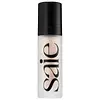Milk Makeup Bionic Glow Hydrating Liquid Illuminator Versus Saie Glowy Super Gel Lightweight Dewy Highlighter
What's inside
What's inside
 Key Ingredients
Key Ingredients

 Benefits
Benefits

 Concerns
Concerns

 Ingredients Side-by-side
Ingredients Side-by-side

Prunus Cerasus Fruit Water
EmollientC10-18 Triglycerides
EmollientCaprylic/Capric Triglyceride
MaskingGlycerin
HumectantPentylene Glycol
Skin ConditioningButylene Glycol
HumectantMica
Cosmetic Colorant1,2-Hexanediol
Skin ConditioningSodium Acrylates Copolymer
Water
Skin ConditioningAcacia Senegal Gum
MaskingZea Mays Starch
AbsorbentGanoderma Lucidum Stem Extract
Skin ConditioningTremella Fuciformis Sporocarp Extract
AntioxidantHydrolyzed Pea Protein
EmollientSr-Hydrozoan Polypeptide-1
HumectantTocopheryl Acetate
AntioxidantGlucose
HumectantLecithin
EmollientGlyceryl Caprylate/Caprate
EmollientSodium Gluconate
Skin ConditioningPotassium Hydroxide
BufferingSodium Chloride
MaskingSodium Succinate
BufferingTin Oxide
AbrasiveSodium Hyaluronate
HumectantSodium Benzoate
MaskingPhenoxyethanol
PreservativePotassium Sorbate
PreservativeParfum
MaskingCI 77891
Cosmetic ColorantIron Oxides
Prunus Cerasus Fruit Water, C10-18 Triglycerides, Caprylic/Capric Triglyceride, Glycerin, Pentylene Glycol, Butylene Glycol, Mica, 1,2-Hexanediol, Sodium Acrylates Copolymer, Water, Acacia Senegal Gum, Zea Mays Starch, Ganoderma Lucidum Stem Extract, Tremella Fuciformis Sporocarp Extract, Hydrolyzed Pea Protein, Sr-Hydrozoan Polypeptide-1, Tocopheryl Acetate, Glucose, Lecithin, Glyceryl Caprylate/Caprate, Sodium Gluconate, Potassium Hydroxide, Sodium Chloride, Sodium Succinate, Tin Oxide, Sodium Hyaluronate, Sodium Benzoate, Phenoxyethanol, Potassium Sorbate, Parfum, CI 77891, Iron Oxides
Water
Skin ConditioningCaprylic/Capric Triglyceride
MaskingPropanediol
SolventGlycerin
HumectantMica
Cosmetic ColorantHydroxyethyl Acrylate/Sodium Acryloyldimethyl Taurate Copolymer
Emulsion StabilisingSqualane
EmollientCaprylyl Glycol
EmollientPhenethyl Alcohol
MaskingEthylhexylglycerin
Skin ConditioningPolysorbate 60
EmulsifyingAscorbyl Tetraisopalmitate
AntioxidantCarica Papaya Seed Oil
HumectantRosa Canina Fruit Oil
EmollientLactic Acid
BufferingCI 77891
Cosmetic ColorantCI 77491
Cosmetic ColorantWater, Caprylic/Capric Triglyceride, Propanediol, Glycerin, Mica, Hydroxyethyl Acrylate/Sodium Acryloyldimethyl Taurate Copolymer, Squalane, Caprylyl Glycol, Phenethyl Alcohol, Ethylhexylglycerin, Polysorbate 60, Ascorbyl Tetraisopalmitate, Carica Papaya Seed Oil, Rosa Canina Fruit Oil, Lactic Acid, CI 77891, CI 77491
 Reviews
Reviews

Ingredients Explained
These ingredients are found in both products.
Ingredients higher up in an ingredient list are typically present in a larger amount.
This ingredient is an emollient, solvent, and texture enhancer. It is considered a skin-softener by helping the skin prevent moisture loss.
It helps thicken a product's formula and makes it easier to spread by dissolving clumping compounds.
Caprylic Triglyceride is made by combining glycerin with coconut oil, forming a clear liquid.
While there is an assumption Caprylic Triglyceride can clog pores due to it being derived from coconut oil, there is no research supporting this.
Learn more about Caprylic/Capric TriglycerideCi 77891 is a white pigment from Titanium dioxide. It is naturally found in minerals such as rutile and ilmenite.
It's main function is to add a white color to cosmetics. It can also be mixed with other colors to create different shades.
Ci 77891 is commonly found in sunscreens due to its ability to block UV rays.
Learn more about CI 77891Glycerin is already naturally found in your skin. It helps moisturize and protect your skin.
A study from 2016 found glycerin to be more effective as a humectant than AHAs and hyaluronic acid.
As a humectant, it helps the skin stay hydrated by pulling moisture to your skin. The low molecular weight of glycerin allows it to pull moisture into the deeper layers of your skin.
Hydrated skin improves your skin barrier; Your skin barrier helps protect against irritants and bacteria.
Glycerin has also been found to have antimicrobial and antiviral properties. Due to these properties, glycerin is often used in wound and burn treatments.
In cosmetics, glycerin is usually derived from plants such as soybean or palm. However, it can also be sourced from animals, such as tallow or animal fat.
This ingredient is organic, colorless, odorless, and non-toxic.
Glycerin is the name for this ingredient in American English. British English uses Glycerol/Glycerine.
Learn more about GlycerinMica is a naturally occurring mineral used to add shimmer and color in cosmetics. It can also help improve the texture of a product or give it an opaque, white/silver color.
Serecite is the name for very fine but ragged grains of mica.
This ingredient is often coated with metal oxides like titanium dioxide. Trace amounts of heavy metals may be found in mica, but these metals are not harmful in our personal products.
Mica has been used since prehistoric times throughout the world. Ancient Egyptian, Indian, Greek, Roman, Aztec, and Chinese civilizations have used mica.
Learn more about MicaWater. It's the most common cosmetic ingredient of all. You'll usually see it at the top of ingredient lists, meaning that it makes up the largest part of the product.
So why is it so popular? Water most often acts as a solvent - this means that it helps dissolve other ingredients into the formulation.
You'll also recognize water as that liquid we all need to stay alive. If you see this, drink a glass of water. Stay hydrated!
Learn more about Water